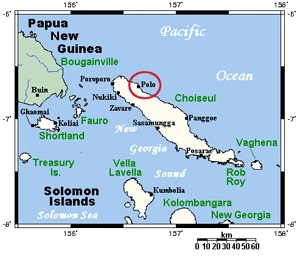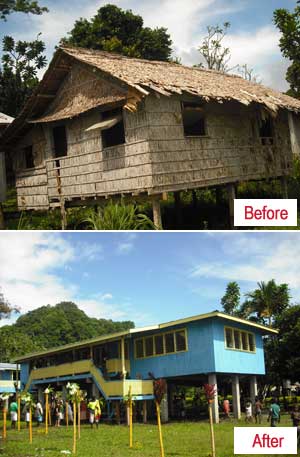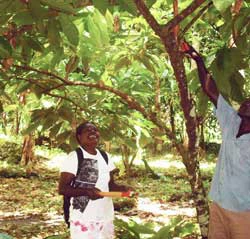 |
| Map courtesy of Wikipedia through a Creative Commons Attribution-Share Alike 3.0 Unported license. |
Taking development to the outlying provinces of Solomon Islands is not an easy ride. I found this out when going on a site visit to the Rural Development Program (RDP) at the country’s far western province of Choiseul.
At the Northwest region of Choiseul province where the island faces open waters that span to the Micronesian archipelago of the Pacific lies a village called Polo. The Polo community has a primary school that was established in 1957 when Solomon Islands was still a British Protectorate, prior to independence in 1978. Since its inception, the Polo school never had a permanent classroom building until two years ago when through the RDP participatory process, the community identified the school as their main need.
It took us a bit over one hour and 30 minutes from the provincial capital of Taro Island to reach Polo village after a not-so-fun bumpy ride on a boat powered by two 40 horsepower Yamaha engines. Most community members, however, don’t have access to outboard motors or the required funds for expensive fuel, so to travel they either paddle by canoe, or wait for one of the irregular cargo boats to travel to Taro or Honiara, the national capital.
 |
| The Polo school is now a permanent structure with three classrooms at the upper floor and three more being added to the lower floor. |
As we throttled our way to shore, we were greeted by a man with a club in one hand and a spear in the other, speaking a customary greeting in the Varisi language of Northwest Choiseul, accompanied by most of the village. According to the school’s headmaster, 170 children from pre-school to year 6 used to attend Polo primary school under thatched roof buildings. That is now a thing of the past. A new permanent two-storey building was recently completed and is ready for use by at least three classes which occupy the top floor. The bottom floor is being constructed to accommodate three additional classrooms.
Women were particularly happy as their children now have a decent place to get an education. Ivy Vilaka, wife of the local area politician said women had helped to carry timber for the building because they wanted the classrooms to be completed quickly. “We believe our children’s new learning environment will help open up their minds a bit more to receive the education they need,” she continued.
The headmaster was so impressed with RDP not only because the program provided the first ever permanent classroom building to his school, but it had taught him lessons in procurement and the managerial skills he needs to administer school funds.
From Polo we headed to the communities of Sirovanga and Molevanga, at the part of the island facing the neighboring Papua New Guinea island of Bougainville. At Sirovanga we walked for over 40 minutes up a mountain slope, through extremely muddy terrains and bushes to reach two bridges, built over a stream. In times of heavy rain and flooding, the stream often prevented students from attending school and walking through mud has become a daily activity for some children. Now that the bridges are built, the attendance rate during the rains is now much higher.
 |
| Pruning cocoa trees will help farmers get better yield. |
Once we left Sirovanga – muddy and tired – we headed straight to the nearby village of Molevanga, which sits at the northern tip of the island. There, as part of Component 2 of the RDP, fuel and other logistical resources were made available to enable Ministry of Agriculture extension staff to teach cocoa farmers how to prune their trees. More than 10 farmers received the training and were extremely excited. Most of them have not had a good harvest in many years due to oversized trees producing little yield.
Gabriel Hiele, the national coordinator for RDP Component 2 said the simple pruning demonstration could result in tangible benefits for the cocoa farmers. “It is important to prune the trees so that the food they receive is not wasted,” he said.
At the cocoa pruning demo, we met Brenda Kavakesa, a Ministry of Agriculture and Livestock (MAL) officer. With her was Teisi, a more junior officer doing her internship with the MAL in Choiseul province after graduating with a degree in tropical agriculture from the local college. She was able to watch and learn from the more experienced MAL officers delivering the training. Being the key trainer, and a woman, Brenda stood out among the MAL officers. At Polo village where we visited earlier in the day, Brenda provided vegetable seeds to the women under the Women in Agriculture Strategy in the Ministry. Many of the women we spoke to expressed appreciation for the program and for being shown how to sow the seeds and grow them – something they were never taught before.
“The vegetables we grow supplement our family diet. Some of us sell their vegetables to the logging camps which are not far from here for a small income. We are really happy to receive help from the Agriculture extension team in Taro,” two of the women, Ivy and Selly told us.
After visiting the cocoa farmers at Molevanga village, we headed back to the provincial capital Taro, where we stayed for our visit. I couldn’t help but think of the distances we travelled to get to those three communities in a day, and at the high cost of rolling RDP out to remote communities. But the visit has helped me appreciate the dedication and commitment of RDP Provincial team members and community helpers.


Join the Conversation